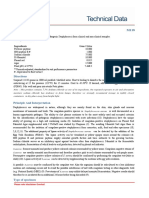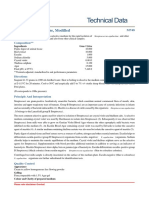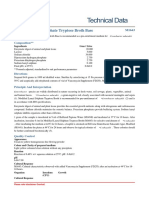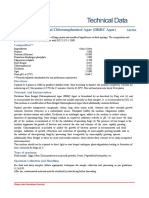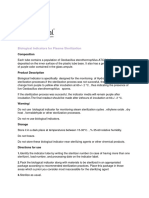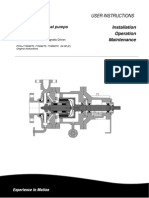LQ007A
LQ007A
Uploaded by
பொ.தெய்வராஜன்Copyright:
Available Formats
LQ007A
LQ007A
Uploaded by
பொ.தெய்வராஜன்Original Title
Copyright
Available Formats
Share this document
Did you find this document useful?
Is this content inappropriate?
Copyright:
Available Formats
LQ007A
LQ007A
Uploaded by
பொ.தெய்வராஜன்Copyright:
Available Formats
Thioglycollate Broth LQ007A
Intended Use
Recommended for the recovery of anaerobic and facultative microorganisms. Sterile, in glass bottles.
Composition**
Ingredients Gms / Litre
Tryptone 15.000
Yeast extract 5.000
Dextrose (Glucose) 5.500
Sodium chloride 2.500
L-Cystine 0.500
Sodium thioglycollate 0.500
Final pH ( at 25°C) 7.1±0.2
**Formula adjusted, standardized to suit performance parameters
Directions
Label the ready to use blood culture bottle. Remove the Aluminium foil cap. Disinfect the part of the rubber stopper which is
now exposed. Draw patient's blood with the sterile or disposable needle and syringe as explained in specimen collection and
disposable column. Transfer the blood sample immediately into the culture bottle by puncturing the rubber stopper with the
needle and injecting the blood. Venting: Use sterile venting needle (LA038). Keep the bottle in an upright position preferably
in a biological safety cabinet, place an alcohol swab over the rubber stopper and insert the venting needle with filter through
it. Insertion and withdrawal of the needle should be done in a straight line. discard the needle and mix the contents by gently
inverting the bottle 2-3 times. Do Not vent the bottle for anaerobic cultures. Incubate at 35-37°C for 24-72 hours and further
for seven days.
Principle And Interpretation
Alternative Thioglycollate Medium is formulated as described in the N.I.H. memorandum (5). It is used for the sterility
testing of certain biological products which are turbid or viscous. Both the media have similar composition, except agar and
resazurin that are not included in Alternative Thioglycollate Medium. This deletion makes it suitable for sterility testing of
viscous products. Tryptone serves as a source of nitrogen and carbon compounds, long chain amino acids and other essential
nutrients. Yeast extract serve as source of essential nutrients to the contaminants, if present. Dextrose serves as the energy
source. Sodium chloride maintains the osmotic equilibrium of the medium whereas L-cystine, an amino acid, also serves as
source of essential growth factors. Sodium thioglycollate and L-cystine lower the oxidation-reduction potential of the
medium by removing oxygen to maintain a low Eh. Sodium thioglycollate also helps to neutralize the toxic effects of
mercurial preservatives (6,7).
Type of specimen
Clinical : wound swabs, skin swabs or scrapings, tooth tartar etc. Pharmaceutical: Sterility testing of viscous products.
Specimen Collection and Handling
For clinical samples follow appropriate techniques for handling specimens as per established guidelines (1,2).
For pharmaceutical products, follow appropriate techniques for sample processing in case of viscous materials as mentioned
under sterility. (8)
Warning and Precautions
In Vitro diagnostic use only. Read the label before opening the container. Wear protective gloves/protective clothing/
eye protection/face protection. Follow good microbiological lab practices while handling specimens and culture. Standard
precautions as per established guidelines should be followed while handling clinical specimens. Safety guidelines may be
referred in individual safety data sheets.
Please refer disclaimer Overleaf.
HiMedia Laboratories Technical Data
Limitations
1. Proper anaerobic conditions must be maintained for optimal recovery of organisms
Performance and Evaluation
Performance of the medium is expected when used as per the direction on the label within the expiry period when stored
at recommended temperature.
Quality Control
Appearance
Sterile clear Thioglycollate Broth in glass bottle
Colour
Light yellow coloured clear solution.
Quantity of Medium
70ml of medium in glass bottle. (For Adult Use)
Reaction
6.90-7.30
Sterility test
Passes release criteria
Cultural response
Cultural characteristics was observed after incubation at 35-37°C for 24-72 hours
Organism Inoculum Growth under Growth under
(CFU) anaerobic conditions aerobic conditions
*Clostridium sporogenes 50 -100 luxuriant -
ATCC 19404 (00008*)
*Clostridium sporogenes 50 -100 luxuriant -
ATCC 11437
*Clostridium sporogenes 50 -100 luxuriant -
NBRC 14293
*Clostridium perfringens 50 -100 luxuriant -
ATCC 13124 (00007*)
Staphylococcus aureus 50 -100 - luxuriant
subsp. aureus ATCC
25923 (00034*)
Staphylococcus aureus 50 -100 - luxuriant
subsp. aureus ATCC 6538
(00032*)
Pseudomonas aeruginosa 50 -100 - luxuriant
ATCC 27853 (00025*)
Pseudomonas aeruginosa 50 -100 - luxuriant
ATCC 9027 (00026*)
Escherichia coli ATCC 50 -100 - luxuriant
25922 (00013*)
Escherichia coli ATCC 8739 50 -100 -
luxuriant
(00012*)
Escherichia coli NCTC 9002 50 -100 - luxuriant
Salmonella Abony NCTC 50 -100 - luxuriant
6017 (00029*)
Salmonella Typhimurium 50 -100 - luxuriant
ATCC 14028 (00031*)
*Bacteroides fragilis ATCC 50 -100 luxuriant -
23745
* Bacteroides vulgatus ATCC 50 -100 luxuriant -
8482
Key : *Corresponding WDCM numbers.
Please refer disclaimer Overleaf.
HiMedia Laboratories Technical Data
Storage and Shelf Life
Store between 2-8°C. Use before expiry date on the label.
Product performance is best if used within stated expiry period.
Disposal
User must ensure safe disposal by autoclaving and/or incineration of used or unusable preparations of this product. Follow
established laboratory procedures in disposing of infectious materials and material that comes into contact with clinical
sample must be decontaminated and disposed of in accordance with current laboratory techniques (1,2).
Reference
1.Isenberg, H.D. Clinical Microbiology Procedures Handbook. 2nd Edition.
2. Jorgensen,J.H., Pfaller , M.A., Carroll, K.C., Funke, G., Landry, M.L., Richter, S.S and Warnock., D.W. (2015)
Manual of Clinical Microbiology, 11th Edition. Vol. 1.
3. Lapage S., Shelton J. and Mitchell T., 1970, Methods in Microbiology', Norris J. and Ribbons D., (Eds.), Vol. 3A, Academic
Press, London.
4. MacFaddin J. F., 2000, Biochemical Tests for Identification of Medical Bacteria, 3rd Ed., Lippincott, Williams and Wilkins,
Baltimore.
5. N.I.H. Memorandum, 1955: Culture Media for Sterility Tests, 4th Revision.
6. Nungester, Hood and Warren, 1943, Proc. Soc. Exp. Biol. Med., 52: 287
7. Portwood, 1944, J. Bacteriol., 48: 255
8.The United States Pharmacopoeia, 2019, The United States Pharmacopoeial Convention.Rockville, MD.
Revision : 00 / 2019
In vitro diagnostic medical
IVD device
CE Marking
25°C Storage temperature
15°C
Do not use if package is
damaged
HiMedia Laboratories Pvt. Limited,
23 Vadhani Industrial Estate,
LBS Marg,Mumbai-86,MS,India
CE Partner 4U ,Esdoornlaan 13, 3951
EC REP
DB Maarn The Netherlands,
www.cepartner 4u.eu
Disclaimer :
User must ensure suitability of the product(s) in their application prior to use. Products conform solely to the information contained in
this and other related HiMedia™ publications. The information contained in this publication is based on our research and development
work and is to the best of our knowledge true and accurate. HiMedia™ Laboratories Pvt Ltd reserves the right to make changes to
specifications and information related to the products at any time. Products are not intended for human or animal or therapeutic use but
for laboratory,diagnostic, research or further manufacturing use only, unless otherwise specified. Statements contained herein should not
be considered as a warranty of any kind, expressed or implied, and no liability is accepted for infringement of any patents.
HiMedia Laboratories Pvt. Ltd. Reg.office : 23, Vadhani Ind.Est., LBS Marg, Mumbai-400086, India. Customer care No.: 022-6116 9797 Corporate office :
A-516,Swastik Disha Business Park,Via Vadhani Ind. Est., LBS Marg, Mumbai-400086, India. Customer care No.: 022-6147 1919 Email:
techhelp@himedialabs.com Website: www.himedialabs.com
You might also like
- Introductory Report On GlenmarkDocument33 pagesIntroductory Report On GlenmarkSai Gautham50% (2)
- What Is Meant by Solid Waste Management?Document14 pagesWhat Is Meant by Solid Waste Management?Prashant JhaNo ratings yet
- TDS M009Document3 pagesTDS M009florengrace.fg98No ratings yet
- Technical Data: Enriched Thioglycollate BrothDocument3 pagesTechnical Data: Enriched Thioglycollate Brothபொ.தெய்வராஜன்No ratings yet
- Clostridial Agar: Intended UseDocument3 pagesClostridial Agar: Intended Usesg.comNo ratings yet
- Mannitol Salt Agar: Intended UseDocument4 pagesMannitol Salt Agar: Intended UseoktaNo ratings yet
- Sabouraud Dextrose Broth (Sabouraud Liquid Medium) : Intended UseDocument3 pagesSabouraud Dextrose Broth (Sabouraud Liquid Medium) : Intended UseCintya Arum SariNo ratings yet
- TSB Cap4 W/tween 80 (Twin Pack) : Intended Use: CompositionDocument3 pagesTSB Cap4 W/tween 80 (Twin Pack) : Intended Use: CompositionazedaaNo ratings yet
- Technical Data: Plate Count Agar (Standard Methods Agar)Document2 pagesTechnical Data: Plate Count Agar (Standard Methods Agar)பொ.தெய்வராஜன்No ratings yet
- SMH118CDocument4 pagesSMH118CNanthicha KrajangpawNo ratings yet
- MH118Document4 pagesMH118Nanthicha KrajangpawNo ratings yet
- Msa PDFDocument4 pagesMsa PDFARATHY M NAIR 2147718No ratings yet
- M121IDocument2 pagesM121IventyfaniaNo ratings yet
- M1991IDocument3 pagesM1991IWindi LestariNo ratings yet
- CR014Document3 pagesCR014Nabila Putri SabilaNo ratings yet
- Hicrome™ Ecc Selective Agar Base: Intended Use: CompositionDocument3 pagesHicrome™ Ecc Selective Agar Base: Intended Use: Compositionafiifa1015No ratings yet
- MH581Document3 pagesMH581Abid Iqbal ARDNo ratings yet
- M008SDocument3 pagesM008Sanulorance98No ratings yet
- M031IDocument3 pagesM031Idarrendelfinoy9No ratings yet
- Sabouraud Cycloheximide Chloramphenicol Agar: Intended UseDocument3 pagesSabouraud Cycloheximide Chloramphenicol Agar: Intended UsenadyasantikaNo ratings yet
- GMH290Document3 pagesGMH290CarolinaYepesBarcinillaNo ratings yet
- Stuart Transport Medium (Transport Medium, Stuart) : Intended UseDocument3 pagesStuart Transport Medium (Transport Medium, Stuart) : Intended Useradiny audiaNo ratings yet
- ™ Ec O157:H7 Agar, Modified: HicromeDocument3 pages™ Ec O157:H7 Agar, Modified: Hicromediana benites salcedoNo ratings yet
- Urea Broth Base (Diagnostic Stuarts Urea Broth Base) : Intended UseDocument3 pagesUrea Broth Base (Diagnostic Stuarts Urea Broth Base) : Intended Use10605114No ratings yet
- Plate Count Agar (Standard Methods Agar) : Intended UseDocument3 pagesPlate Count Agar (Standard Methods Agar) : Intended UsenuraenirianNo ratings yet
- Agar EdwardsDocument2 pagesAgar EdwardsGeraldine CacaceNo ratings yet
- Dey-Engley Neutralizing BrothDocument2 pagesDey-Engley Neutralizing BrothAnonymous WxIzg7tNo ratings yet
- MP5332Document3 pagesMP5332satyen.ghosh1111No ratings yet
- RM007Document3 pagesRM007Gopi NathNo ratings yet
- Littman Oxgall Agar W/ Streptomycin: Intended UseDocument1 pageLittman Oxgall Agar W/ Streptomycin: Intended UseJUAN PABLO VERGARA REYESNo ratings yet
- BETA-SSA Agar (Group A Streptococci Selective Agar)Document3 pagesBETA-SSA Agar (Group A Streptococci Selective Agar)uttam.micro404No ratings yet
- MH144 SJSMSNDocument3 pagesMH144 SJSMSNsulistyani sapardiNo ratings yet
- Principle Typical Composition (G/litre) Preparation Ordering InformationDocument1 pagePrinciple Typical Composition (G/litre) Preparation Ordering InformationZoza SalamaNo ratings yet
- TDS - M449-TSA With Lecithin & Polysorbate 80Document3 pagesTDS - M449-TSA With Lecithin & Polysorbate 80florengrace.fg98No ratings yet
- TDS MH443Document3 pagesTDS MH443florengrace.fg98No ratings yet
- M1643 LSTB MediumDocument2 pagesM1643 LSTB Mediumayuningtyas wahyuNo ratings yet
- TechnicalDocument2 pagesTechnicalnafiw31466No ratings yet
- MM242Document3 pagesMM242Anand H SNo ratings yet
- Ma PDFDocument4 pagesMa PDFARATHY M NAIR 2147718No ratings yet
- Tryptic Soya Agar: Intended UseDocument2 pagesTryptic Soya Agar: Intended UseGopi NathNo ratings yet
- Haematoxylin (Harris) : Intended Use: CompositionDocument3 pagesHaematoxylin (Harris) : Intended Use: Compositionyohanes e. gunawanNo ratings yet
- Chloran Rose Bengal Chloramphenicol Agar (DRBC Agar) : Intended UseDocument3 pagesChloran Rose Bengal Chloramphenicol Agar (DRBC Agar) : Intended Useபொ.தெய்வராஜன்No ratings yet
- Lysine Decarboxylase PDFDocument3 pagesLysine Decarboxylase PDFSherly MardianaNo ratings yet
- Tn1363en MKDocument3 pagesTn1363en MKFlorencia PieragostiniNo ratings yet
- Sabouraud Dextrose Broth (Sabouraud Liquid Medium) : CompositionDocument2 pagesSabouraud Dextrose Broth (Sabouraud Liquid Medium) : CompositionTofik HidayatNo ratings yet
- Pseudomonas Isolation HiCynth™ Agar BaseDocument2 pagesPseudomonas Isolation HiCynth™ Agar Baseuttam.micro404No ratings yet
- Acetate Agar: Intended UseDocument2 pagesAcetate Agar: Intended UseMIcro LabNo ratings yet
- Mitis Salivarius Agar Base: CompositionDocument2 pagesMitis Salivarius Agar Base: CompositionAbid SiddiquiNo ratings yet
- Grams Stain-Kit: CompositionDocument3 pagesGrams Stain-Kit: Compositionhamza hamzaNo ratings yet
- Blood Agar Base (Infusion Agar) : Intended UseDocument3 pagesBlood Agar Base (Infusion Agar) : Intended UseJohnree A. EvangelistaNo ratings yet
- RM001Document3 pagesRM001AbdulrahmanNo ratings yet
- M1297ADocument3 pagesM1297Ateena jacobNo ratings yet
- Gifu Anaerobic Broth (GAM) : Intended UseDocument3 pagesGifu Anaerobic Broth (GAM) : Intended UseVishwanath Unique BiotechNo ratings yet
- TDS M198Document3 pagesTDS M198Muhammad ErdiansyahNo ratings yet
- BBL™ Mannitol Salt Agar - BDDocument2 pagesBBL™ Mannitol Salt Agar - BDyyewelsNo ratings yet
- MB PDFDocument3 pagesMB PDFARATHY M NAIR 2147718No ratings yet
- Pseudomonas Agar (For Pyocyanin) (In A Accordance With IP 2007)Document2 pagesPseudomonas Agar (For Pyocyanin) (In A Accordance With IP 2007)sezinaltiokkNo ratings yet
- Baird Parker Agar Base: Intended UseDocument4 pagesBaird Parker Agar Base: Intended UseKishiro LeyritanaNo ratings yet
- M001 PDFDocument3 pagesM001 PDFkeresahanmuNo ratings yet
- 4a Biyolojik İndikatör Analiz SertifikasıDocument3 pages4a Biyolojik İndikatör Analiz SertifikasısezinaltiokkNo ratings yet
- Technical Data: Peptone WaterDocument3 pagesTechnical Data: Peptone WaterAbdulrahmanNo ratings yet
- Practical Manual for Detection of Parasites in Feces, Blood and Urine SamplesFrom EverandPractical Manual for Detection of Parasites in Feces, Blood and Urine SamplesNo ratings yet
- Furnace Gks9090Document40 pagesFurnace Gks9090Rich BentoNo ratings yet
- 09 M.S. 073 SOALANDocument1 page09 M.S. 073 SOALANSAHDANAH MUDALIYAR A/P TUN SAMBANTHAN MoeNo ratings yet
- ccc10-1 2018 222Document10 pagesccc10-1 2018 222Efari BahcevanNo ratings yet
- 15th GroupDocument37 pages15th GroupSai Sasivardhan GampaNo ratings yet
- Cymbopogon Nardus 2Document8 pagesCymbopogon Nardus 2wulanNo ratings yet
- Kuliah 3 Pipa Bawah Laut 2017Document72 pagesKuliah 3 Pipa Bawah Laut 2017ndarimuahNo ratings yet
- 2009 Crop Production Guide: 2008 Climatic SummaryDocument4 pages2009 Crop Production Guide: 2008 Climatic SummaryGichuru K RiriaNo ratings yet
- Is 1865 1991Document16 pagesIs 1865 1991kumarkk1969No ratings yet
- E 199 SolDocument10 pagesE 199 SolDavid Alemán SánchezNo ratings yet
- User Instructions: ERPN-M Centrifugal PumpsDocument37 pagesUser Instructions: ERPN-M Centrifugal Pumpstexwan_No ratings yet
- Techfinix PVT LTDDocument28 pagesTechfinix PVT LTDshrikant_pesitNo ratings yet
- Teknikal Proposal Tangki Sambu T-32 LengkapDocument17 pagesTeknikal Proposal Tangki Sambu T-32 Lengkapveva santi100% (1)
- ADVIA 1800 2400 APTools v1.08 Customer Information, EN, 11222505 DXDCM 09017fe98041dd77-1585019566452Document18 pagesADVIA 1800 2400 APTools v1.08 Customer Information, EN, 11222505 DXDCM 09017fe98041dd77-1585019566452robin.luNo ratings yet
- JasmonatesDocument38 pagesJasmonatesSpinu LiliaNo ratings yet
- Flavor ModulationDocument4 pagesFlavor Modulationcel012b1No ratings yet
- Fosroc Polyurea WPE 0518Document5 pagesFosroc Polyurea WPE 0518RiverPlaceNo ratings yet
- Tor 65Document1 pageTor 65topoginoNo ratings yet
- ALFA LAVAL Refinery 2011 External PDFDocument26 pagesALFA LAVAL Refinery 2011 External PDFProcess EngineerNo ratings yet
- Class 8 - Practice PaperDocument11 pagesClass 8 - Practice PaperVrushik VadherNo ratings yet
- NSEB Solved PaperDocument15 pagesNSEB Solved Papershruti.fedbankNo ratings yet
- MSDS Hardener HW 2934 PDFDocument13 pagesMSDS Hardener HW 2934 PDFmina_karaliNo ratings yet
- CHEN4235 - Lecture - Surface StructureDocument31 pagesCHEN4235 - Lecture - Surface StructureAmadeus HuangNo ratings yet
- The Jamaican CherryDocument5 pagesThe Jamaican CherryGemma Joy GimenezNo ratings yet
- 22 Feb Goc 1 - OneDocument19 pages22 Feb Goc 1 - OneShreyaNo ratings yet
- PEX - 75-Range-Plascoguard-Zinc-Phosphate-Epoxy-PrimerDocument2 pagesPEX - 75-Range-Plascoguard-Zinc-Phosphate-Epoxy-Primersarcozy922No ratings yet
- Chemical Bonding and Molecular Structure: ValencyDocument11 pagesChemical Bonding and Molecular Structure: ValencyD SNo ratings yet
- Economiser LiteratureDocument7 pagesEconomiser LiteratureSteve M D'souzaNo ratings yet
- Chapter 17Document35 pagesChapter 17Sigmund PohanNo ratings yet











